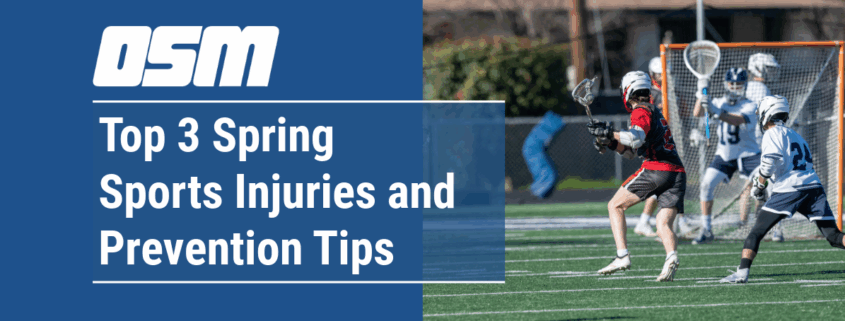Top 3 Spring Sports Injuries and Prevention Tips
Article featured on NY Orthopedics
Spring brings a new season of weather—and sports! Baseball, softball, lacrosse, track and field, soccer, tennis, and golf just to name a few. There are a wide variety of sports available during the Spring. With an increase or shift in physical activity, people can be particularly prone to injury playing Spring sports.
STRESS FRACTURES
In sports that require running or high impact on joints, there ca be an increased risk of stress fractures in the feet, ankles, and shins.
What causes a stress fracture?
Stress fractures are an overuse injury that happens when a break or crack appear due to continuous stress put on the bone. These can appear anywhere on the bone, but is most commonly seen in feet and tibia (shin bone) on individuals who are running often.
How can I prevent stress fractures when playing Spring sports?
Gradually increasing time spent running will help in the prevention of stress fractures. Generally, increasing the amount of running or high-impact exercise by less than 10% week-to-week is advised for injury prevention.
Cross-training is also an effective way to ensure a more evenly distributed load of training across the body. Biking, swimming, and even walking are great cross-training options.
Even when you aren’t playing sports, wear supportive footwear that protects the integrity of your feet and ankles.
Lastly, stop exercising if you feel pain. Pushing through true pain and continuing elevates your risk for a stress fracture. If you have persistent pain during exercise, it’s best to rest and see your orthopedic doctor for evaluation.
TENNIS ELBOW & GOLFER’S ELBOW
Both tennis and golfer’s elbow are usually the result of repetitive strain on the tendons that attach your forearm muscles to the elbow bone. And while very similar, these two conditions actually are different.
Tennis elbow (lateral epicondylitis) affects the tendons attached to the outer side of your elbow, which are connected to the muscles that extend your wrist backward and straighten your fingers.
Golfer’s elbow (medial epicondylitis) affects the tendons connected to the inner side of your elbow, which are attached to the muscles that flex your wrist and contract your fingers when you grip something.
How can I prevent tennis elbow and golfer’s elbow?
Proper technique and form when playing these sports is critical. Avoid over-squeezing the racket or golf club, avoid excessively twisting the wrist, and take breaks during prolonged playing.
Ensure you have the proper equipment and that it is customized for individual use. For instance, in tennis, you may consider having your racket’s string tension adjusted to a lower level to decrease the impact on the arm.
Regularly stretching and strengthening your forearms can also be helpful in injury prevention. It is also important to allow time for rest and recovery. Avoid playing through pain as it can worsen the condition.
ACL INJURY
The anterior cruciate ligament (ACL) is a band of tissues in the knee that connects the femur (thigh bone) to the tibia (shin bone) and stabilizes the knee.
What causes an ACL injury?
An ACL injury is a tear or sprain of the anterior cruciate ligament. Fortunately, this isn’t usually an everyday injury. ACL injuries typically occur during sports or exercises that involve sudden stops, jumping and landing, or quick changes in direction—like in soccer, tennis, lacrosse or track and field.
How can I prevent an ACL injury during Spring sports?
Avoid tearing your ACL by ensuring your foot and your knee are always traveling in the same direction. Opt to play these sports on flat surfaces clear of debris and obstructions. Carefully run corners wide and gently, without sharp turns.
Keeping your knees strengthened with cross-training, and incorporating mobility exercises to help keep ligaments flexible and durable can also help lower the risk of ACL injury.
While these are common injuries for those playing Spring sports, there are several others such as sprained ankle, Achilles tendonitis, plantar fasciitis, shin splints, runner’s knee, IT band syndrome, bursitis, and piriformis syndrome just to name a few.
Regardless of what your injury is, seek medical evaluation if you experience:
- Increased pain
- Increased swelling
- Increased bruising
- Pain is isolated to one side
- Pain or discomfort that does not resolve with a few days of rest
The Orthopedic & Sports Medicine Center of Oregon is an award-winning, board-certified orthopedic group located in downtown Portland Oregon. We utilize both surgical and nonsurgical means to treat musculoskeletal trauma, spine diseases, foot and ankle conditions, sports injuries, degenerative diseases, infections, tumors and congenital disorders.
Our mission is to return our patients back to pain-free mobility and full strength as quickly and painlessly as possible using both surgical and non-surgical orthopedic procedures.
Our expert physicians provide leading-edge, comprehensive care in the diagnosis and treatment of orthopedic conditions, including total joint replacement and sports medicine. We apply the latest state-of-the-art techniques in order to return our patients to their active lifestyle.
If you’re looking for compassionate, expert orthopedic and podiatric surgeons in Portland Oregon, contact OSM today.
Phone:
Address
17355 Lower Boones Ferry Rd Suite 100A
Lake Oswego, OR 97035
Hours
Monday–Friday
8:00am – 4:30pm



